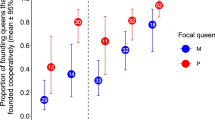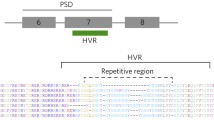Abstract
The role of haplodiploidy in the evolution of eusocial insects and why in Hymenoptera males do not perform any work is presently unknown. We show here that within-colony conflict caused by the coexistence of individuals of the same caste expressing the same character in different ways can be fundamental in the evolution of social characters in species that have already reached the eusocial condition. Mosaic colonies, composed by individuals expressing either the wild-type or a mutant phenotype, inevitably occurs during the evolution of advantageous social traits in insects. We simulated the evolution of an advantageous social trait increasing colony fitness in haplodiploid and diplodiploid species considering all possible conditions, i.e. dominance/recessivity of the allele determining the new social character, sex of the castes, and influence of mosaicism on the colony fitness. When mosaicism lowered colony fitness below that of the colony homogeneous for the wild type allele, the fixation of an advantageous social character was possible only in haplodiploids with female castes. When mosaicism caused smaller reductions in colony fitness, reaching frequencies of 90% was much faster in haplodiploids with female castes and dominant mutations. Our results suggest that the evolution of social characters is easier in haplodiploid than in diplodiploid species, provided that workers are females.




Similar content being viewed by others
References
Alexander RD, Noonan KM, Crespi BJ (1991) The evolution of eusociality. In: Sherman PW, Jarvis JUM, Alexander RD (eds) The Biology of the naked mole-rat. Princeton University Press, Princeton, pp 3–44
Beekman M, Allsopp M, Wossler TC, Oldroyd BP (2008) Factors affecting the dynamics of the honey bee (Apis mellifera) hybrid zone of South Africa. Heredity 100:13–18
Beshers SN, Fewell JH (2001) Models of division of labor in social insects. Annu Rev Entomol 46:413–440
Boch R (1957) Rassennmässige Unterschiede bei den Tänzen der Honigbiene (Apis mellifica L.). Z Vgl Physiol 40:289–320
Bonabeau E, Theraulaz G, Deneubourg JL (1998) Fixed response thresholds and the regulation of division of labor in insect societies. Bull Math Biol 60:753–807
Boomsma JJ (2007) Kin selection versus sexual selection: why the ends do not meet. Curr Biol 17:R673–R683
Crozier RH (2008) Advanced eusociality, kin selection and male haploidy. Aust J Entomol 47:2–8
Fewell JH, Bertram SM (1999) Division of labor in a dynamic environment: response by honeybees (Apis mellifera) to graded changes in colony pollen stores. Behav Ecol Sociobiol 46:171–179
Fuchs S, Moritz RFA (1998) Evolution of extreme polyandry in the honeybee Apis mellifera L. Behav Ecol Sociobiol 9:269–275
Johnson RN, Oldroyd BP, Barron AB, Crozier RH (2002) Genetic control of the honey bee (Apis mellifera) dance language: segregating dance forms in a backcrossed colony. J Hered 93:170–173
Jones J, Myerscough M, Graham S, Oldroyd BP (2004) Honey bee nest thermoregulation: diversity promotes stability. Science 305:402–404
Kerr WE (1997) Sex determination in bees (Apinae, Meliponinae) and its consequences. Braz J Genet 20:601–612
Krieger MJ, Ross KG (2002) Identification of a major gene regulating complex social behaviour. Science 295:328–332
Lattorff HM, Moritz RF, Fuchs S (2005) A single locus determines thelytokous parthenogenesis of laying honeybee workers (Apis mellifera capensis). Heredity 94:533–537
Linksvayer TA, Wade MJ (2005) The evolutionary origin and elaboration of sociality in the aculeate Hymenoptera: maternal effects, sib-social effects, and heterochrony. Q Rev Biol 80:317–336
Morpurgo G, Babudri N (2005) Haplodiploidy and evolution of eusociality in insects. Rend Lincei 16:327–330
Neumann P, Moritz RFA (2002) The Cape honeybee phenomenon: the evolution of a social parasite in real time? Behav Ecol Sociobiol 52:271–281
Oldroyd BP, Fewell JH (2007) Genetic diversity promotes homeostasis in insect colonies. Trends Ecol Evol 22:408–413
Page RE, Fondrk MK, Hunt GJ, Guzmán-Novoa E, Humphries MA, Nguyen K, Greene AS (2000) Genetic dissection of honeybee (Apis mellifera L.) foraging behavior. J Hered 91:474–479
Steche W (1957) Beitraege zur Analyse der Bienentaenze. Insectes Soc 4:305–318
Strassmann JE, Queller DC (2004) Genetic conflicts and intercellular heterogeneity. J Evol Biol 6:1189–1191
Tan K, Yang MX, Radloff SE, Hepburn HR, Zhang ZY, Luo LJ, Li H (2008) Dancing to different tunes: heterospecific deciphering of the honeybee waggle dance. Naturwissenschaften 95:1165–1168
Wilson EO (1971) The insect societies. The Belknap Press of Harvard University Press, Cambridge
Wilson EO, Hölldobler B (2005) Eusociality: origin and consequences. Proc Natl Acad Sci USA 102:13367–13371
Acknowledgment
This work was supported by grants from Fondazione Cassa di Risparmio Perugia.
Author information
Authors and Affiliations
Corresponding author
Rights and permissions
About this article
Cite this article
Morpurgo, G., Babudri, N., Fioretti, B. et al. Mosaicism may explain the evolution of social characters in haplodiploid Hymenoptera with female workers. Genetica 138, 1111–1117 (2010). https://doi.org/10.1007/s10709-010-9515-3
Received:
Accepted:
Published:
Issue Date:
DOI: https://doi.org/10.1007/s10709-010-9515-3




